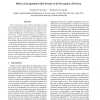Free Online Productivity Tools
i2Speak
i2Symbol
i2OCR
iTex2Img
iWeb2Print
iWeb2Shot
i2Type
iPdf2Split
iPdf2Merge
i2Bopomofo
i2Arabic
i2Style
i2Image
i2PDF
iLatex2Rtf
Sci2ools
HAPTICS
2007
IEEE
2007
IEEE
Effects of Longitudinal Skin Stretch on the Perception of Friction
This work focuses on the relative importance of skin stretch imposed on the fingerpad on the perception of friction. Perceptual data is presented from two separate tests. The first experiment was designed to determine the perceptual thresholds for friction based on a Karnopp friction model. In this experiment friction was rendered as purely a kinesthetic resistance via a PHANToM force feedback device. The second experiment was designed to evaluate possible changes in perceived friction magnitudes due to imposing small amounts of tangential skin stretch (0.25 - 0.75 mm) to the fingerpad in combination with force feedback (kinesthetic resistance). Results of this experiment show that even these small amounts of skin stretch increase the perceived friction. These results suggest that the addition of a simple shear plate tactile display to current haptic devices could significantly enhance the range of rendered friction since most current haptic force feedback devices have limited for...
| Added | 02 Jun 2010 |
| Updated | 02 Jun 2010 |
| Type | Conference |
| Year | 2007 |
| Where | HAPTICS |
| Authors | Nicholas D. Sylvester, William R. Provancher |
Comments (0)

